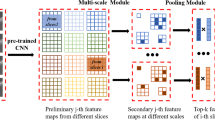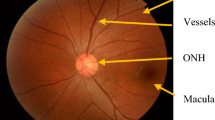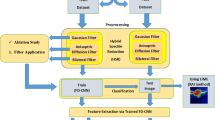Abstract
This study aims to automatically detect multiple sclerosis (MS) in terms of the changes in retinal vessels using Scanning laser ophthalmoscopy (SLO) images. Although much research has been done to diagnose MS patients, these diagnostic techniques have always been based on using Magnetic resonance imaging (MRI) images which cannot be a complete technique in diagnosing this disease. Using SLO images and examining the condition of its vessels using computer technology, biomarkers in the vessel can be identified to help diagnose MS patients. However, in the first step, the color images are converted to gray and after that are improved using a combination of algorithm Tylor Coye and DWT, then, the images are segmented and retinal vessels are extracted. Besides, two different techniques are used in classification stage. In the first technique, classic Machine learning different features are extracted from the resulting regions and entered into several multiple classifiers, the results of which give us an accuracy of 72%, moreover in the second technique segmented images enter the transfer learning model and ultimately lead us to 98% accuracy in the distinction between MS patients and Healthy Controls (HCs).











Similar content being viewed by others
Data availability
Collecting this dataset was approved by the ethics committee of Isfahan University of Medical Sciences and was conducted according to the Declaration of Helsinki in the applicable version.
References
Bhaduri B, Nolan RM, Shelton RL, Pilutti LA, Motl RW, Moss HE, ... Boppart SA (2016) Detection of retinal blood vessel changes in multiple sclerosis with optical coherence tomography. Biomed Opt Exp 7(6):2321–2330
Wang X, Jia Y, Spain R, Potsaid B, Liu JJ, Baumann B, ... Huang D (2014) Optical coherence tomography angiography of optic nerve head and parafovea in multiple sclerosis. Br J Ophthalmol 98(10):1368–1373
Tyler C (2016) A novel retinal blood vessel segmentation algorithm for fundus images. MATLAB Cent. File Exch.
Ridler TW, Calvard S (1978) Picture thresholding using an iterative selection method. IEEE Transactions on Systems, Man, and Cybernetics SMC-8, 630–632
Setiawan W, Damayanti F (2016) Fundus image classification using two dimensional linear discriminant analysis and support vector machine. Int J Adv Eng Manag Sci 2(10):1–6
Kim JK, Park HW (1999) Statistical textural features for detection of microcalcifications in digitized mammograms. IEEE Trans Med Imaging 18(3):231–238
Princye PH, Vijayakumari V (2018) Retinal disease diagnosis by morphological feature extraction and SVM classification of retinal blood vessels. Biomed Res (0970-938X)
Singh A (2019) Feature engineering for images: a valuable introduction to the HOG feature descriptor. Medium, Analytics Vidhya, 4
Hollemans M (2018) MobileNet version 2, April 2018. https://machinethink.net/blog/mobilenet-v2/. Accessed 13 Sept 2019
Shi Z, Wang T, Huang Z, Xie F, Song G (2021) A method for the automatic detection of myopia in Optos fundus images based on deep learning. Int J Numer Methods Biomed Eng 37(6):e3460
Mazumder R, Murchison C, Bourdette D, Cameron M (2014) Falls in people with multiple sclerosis compared with falls in healthy controls. PLoS ONE 9(9):e107620
Wilhelm H, Schabet M (2015) The diagnosis and treatment of optic neuritis. Dtsch Arztebl Int 112(37):616
Cavaliere C, Vilades E, Alonso-Rodríguez MC, Rodrigo MJ, Pablo LE, Miguel JM, ... Garcia-Martin E (2019) Computer-aided diagnosis of multiple sclerosis using a support vector machine and optical coherence tomography features. Sensors 19(23):5323
Khodabandeh Z, Rabbani H, Ashtari F, Zimmermann HG, Motamedi S, Brandt AU, ... Kafieh R (2022) Interpretable classification using occlusion sensitivity on multilayer segmented OCT from patients with Multiple Sclerosis and healthy controls. Preprint available at https://europepmc.org/article/ppr/ppr485221
Dash S, Senapati MR (2020) Enhancing detection of retinal blood vessels by combined approach of DWT, Tyler Coye and Gamma correction. Biomed Signal Process Control 57:101740
Bartosik A, Whittingham H (2021) Evaluating safety and toxicity. In: The era of artificial intelligence, machine learning, and data science in the pharmaceutical industry, pp 119–137. Academic Press
Velázquez-Rodríguez C, Di Nucci D, De Roover C (2023) A text classification approach to API type resolution for incomplete code snippets. Sci Comput Program 227:102941
K-Nearest Neighbor (KNN) Algorithm for Machine Learning. https://www.javatpoint.com/k-nearest-neighbor-algorithm-for-machine-learning. Accessed 5 May 2023
Hastie T, Tibshirani R, Friedman J (2009) Unsupervised learning. In: The elements of statistical learning: Data mining, inference, and prediction, pp 485–585
Piryonesi SM, El-Diraby TE (2020) Data analytics in asset management: Cost-effective prediction of the pavement condition index. J Infrastruct Syst 26(1):04019036
Hastie T, Tibshirani R, Friedman JH (2009) 10. Boosting and additive trees. The elements of statistical learning (2nd ed). New York, Springer, pp. 337–384. ISBN 978-0-387-84857-0. Archived from the original on 2009-11-10
MobileNet v2. https://www.mathworks.com/help/deeplearning/ref/mobilenetv2.html. Accessed 20 Jun 2020
dwt2. https://www.mathworks.com/help/wavelet/ref/dwt2.html. Accessed 8 July 2020
Eslami M, Lichtman-Mikol S, Razmjou S, Bernitsas E (2022) Optical coherence tomography in chronic relapsing inflammatory optic neuropathy, neuromyelitis optica and multiple sclerosis: a comparative study. Brain Sci 12(9):1140
Jiang H, Gameiro GR, Liu Y, Lin Y, Hernandez J, Deng Y, ... Wang J (2020) Visual function and disability are associated with increased retinal volumetric vessel density in patients with multiple sclerosis. Am J Ophthal 213:34–45
ImageNet. http://www.image-net.org. Accessed 11 Mar 2021
Zaki SZM, Zulkifley MA, Stofa MM, Kamari NAM, Mohamed NA (2020) Classification of tomato leaf diseases using MobileNet v2. IAES Int J Artif Intell 9(2):290
Sharp PF, Manivannan A, Xu H, Forrester JV (2004) The scanning laser ophthalmoscope—a review of its role in bioscience and medicine. Phys Med Biol 49(7):1085
Bhat SH, Kumar P (2019) Segmentation of optic disc by localized active contour model in retinal fundus image. In: Smart innovations in communication and computational sciences: proceedings of ICSICCS-2018, pp 35–44. Springer Singapore
Wu X, Lopez M (2017) Multiple sclerosis slice identification by Haar wavelet transform and logistic regression. Adv Eng Res 114:50–55
Fiorini S, Verri A, Tacchino A, Ponzio M, Brichetto G, Barla A (2015) A machine learning pipeline for multiple sclerosis course detection from clinical scales and patient reported outcomes. In: Proceedings of the annual international conference of the IEEE engineering in medicine and biology society, EMBS 2015, Milan, Italy, 25–29 August 2015
Sarbaz Y, Pourakbari H, Vojudi MH, Ghanbari A (2017) Introducing a decision support system for multiple sclerosis based on postural tremor: A hope for separation of people who might be affected by multiple sclerosis in the future. Biomed Eng Appl Basis Commun 29:1750046
Ettema AR, Lenders MWPM, Vliegen J, Slettenaar A, Tjepkema-Cloostermans MC, de Vos CC (2021) Detecting multiple sclerosis via breath analysis using an eNose, a pilot study. J Breath Res 15(2):027101
Lötsch J, Schiffmann S, Schmitz K, Brunkhorst R, Lerch F, Ferreiros N, ... Ultsch A (2018) Machine-learning based lipid mediator serum concentration patterns allow identification of multiple sclerosis patients with high accuracy. Sci Rep 8(1):14884
Kawahara JG (2013) Spinal cord segmentation and disability prediction in multiple sclerosis using novel optimization and machine learning methods. https://summit.sfu.ca/item/13627
Schwab P, Karlen W (2020) A deep learning approach to diagnosing multiple sclerosis from smartphone data. IEEE J Biomed Health Inform 25(4):1284–1291
La Rosa F, Fartaria MJ, Kober T, Richiardi J, Granziera C, Thiran JP, Cuadra MB (2019) Shallow vs deep learning architectures for white matter lesion segmentation in the early stages of multiple sclerosis. In: Brainlesion: Glioma, Multiple Sclerosis, Stroke and Traumatic Brain Injuries: 4th International Workshop, BrainLes 2018, Held in Conjunction with MICCAI 2018, Granada, Spain, September 16, 2018, Revised Selected Papers, Part I 4. pp 142–151. Springer International Publishing
Arsalan M, Haider A, Lee YW, Park KR (2022) Detecting retinal vasculature as a key biomarker for deep Learning-based intelligent screening and analysis of diabetic and hypertensive retinopathy. Expert Syst Appl 200:117009
Olatunji SO, Alsheikh N, Alnajrani L, Alanazy A, Almusairii M, Alshammasi S, ... Alhiyafi J (2023) Comprehensible machine-learning-based models for the pre-emptive diagnosis of multiple sclerosis using clinical data: a retrospective study in the eastern province of Saudi Arabia. Int J Environ Res Public Health 20(5):4261
Bhat SH, Kumar P (2019) Segmentation of optic disc by localized active contour model in retinal fundus image. Smart Innovations in Communication and Computational Sciences: Proceedings of ICSICCS-2018, 35–44.a
Branco D, Martino BD, Esposito A, Tedeschi G, Bonavita S, Lavorgna L (2022) Machine learning techniques for prediction of multiple sclerosis progression. Soft Comput 26(22):12041–12055
Montolío A, CEGONino JOSE, Garcia-Martin E, Pérez del Palomar A (2022) Comparison of machine learning methods using spectralis OCT for diagnosis and disability progression prognosis in multiple sclerosis. Ann Biomed Eng 50(5):507-528
Kenney RC, Liu M, Hasanaj L, Joseph B, Al-Hassan AA, Balk LJ, ... Balcer LJ (2022) The role of optical coherence tomography criteria and machine learning in multiple sclerosis and optic neuritis diagnosis. Neurology 99(11):e1100-e1112
López-Dorado A, Pérez J, Rodrigo MJ, Miguel-Jiménez JM, Ortiz M, de Santiago L, ... Garcia-Martin E (2021) Diagnosis of multiple sclerosis using multifocal ERG data feature fusion. Inf Fusion 76:157–167
Mohseni E, Moghaddasi SM (2022) A hybrid approach for MS diagnosis through nonlinear EEG descriptors and metaheuristic optimized classification learning. Computational Intelligence and Neuroscience. https://doi.org/10.1155/2022/5430528
Acknowledgements
Words cannot express my gratitude to my professors for their invaluable patience and feedback. I also could not have undertaken this journey, who generously provided knowledge and expertise.
Lastly, I would be remiss in not mentioning my family, especially my parents, spouse, and my kid. Their belief in me has kept my spirits and motivation high during this process.
Author information
Authors and Affiliations
Corresponding author
Ethics declarations
Ethical statement
Collecting this dataset was approved by the ethics committee of Isfahan University of Medical Sciences and was conducted according to the Declaration of Helsinki in the applicable version.
Conflicts of interest
All authors declare that they have no conflicts/Competing of interest.
Additional information
Publisher's Note
Springer Nature remains neutral with regard to jurisdictional claims in published maps and institutional affiliations.
Rights and permissions
Springer Nature or its licensor (e.g. a society or other partner) holds exclusive rights to this article under a publishing agreement with the author(s) or other rightsholder(s); author self-archiving of the accepted manuscript version of this article is solely governed by the terms of such publishing agreement and applicable law.
About this article
Cite this article
Yaghoubi, N., Masumi, H., Fatehi, M.H. et al. Deep learning and classic machine learning models in the automatic diagnosis of multiple sclerosis using retinal vessels. Multimed Tools Appl 83, 37483–37504 (2024). https://doi.org/10.1007/s11042-023-16812-w
Received:
Revised:
Accepted:
Published:
Issue Date:
DOI: https://doi.org/10.1007/s11042-023-16812-w




